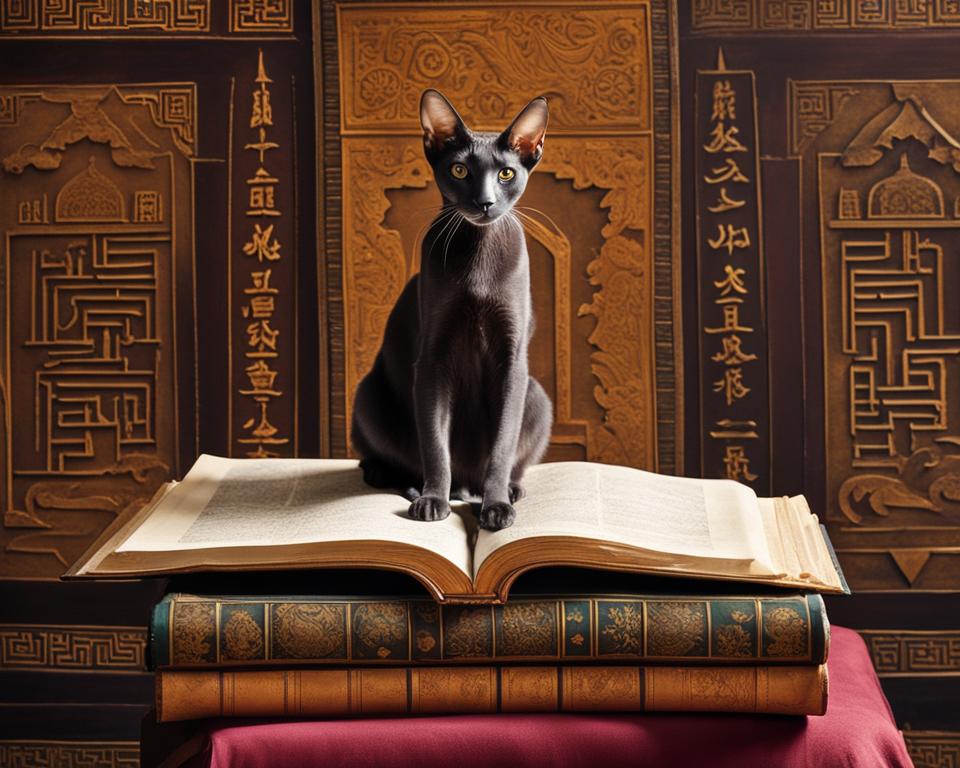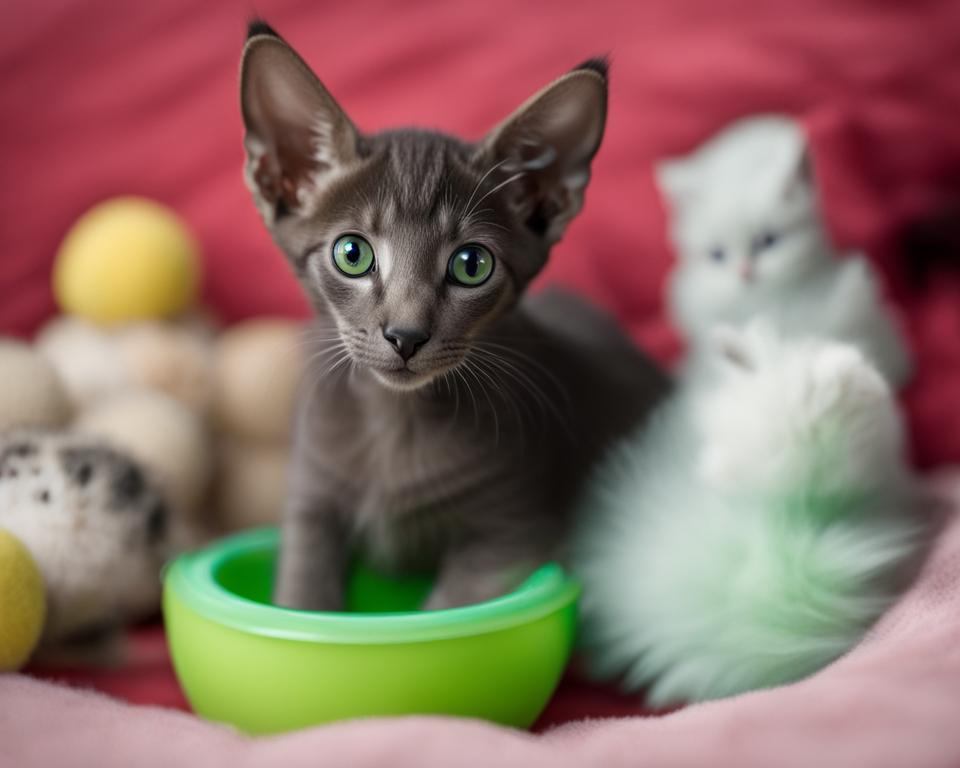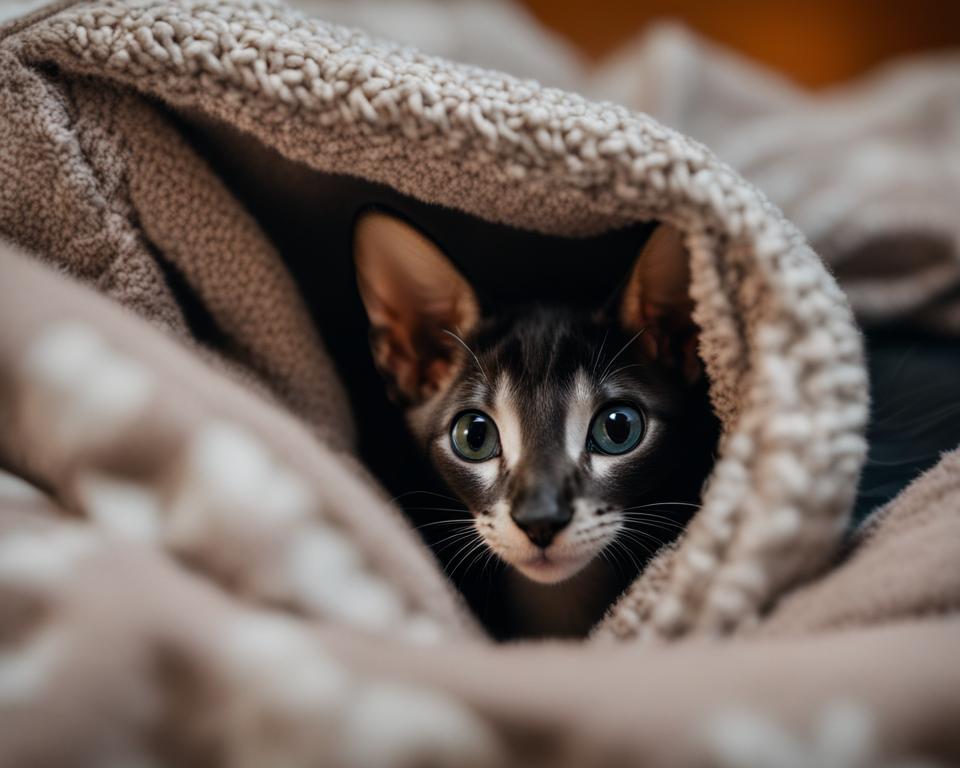The Oriental Shorthair is an elegant and intelligent cat breed that comes in a variety of colors and patterns. They are known for being affectionate, playful, and sociable. This breed is often considered hypoallergenic, making them a great choice for those with allergies. Oriental Shorthairs originated in England and were introduced to the United States in the 1970s. They require regular grooming, interactive stimulation, and a high-quality diet. If you’re interested in adopting an Oriental Shorthair kitten, there are many reputable breeders and rescue organizations that can help you find the perfect feline companion.
Key Takeaways:
- Adopting an Oriental Shorthair kitten can bring joy and companionship to your life.
- The breed is known for their affectionate nature and playful personality.
- Oriental Shorthairs are considered hypoallergenic, making them a great choice for those with allergies.
- Regular grooming, interactive stimulation, and a high-quality diet are important for their well-being.
- There are many reputable breeders and rescue organizations that can help you find an Oriental Shorthair kitten for adoption.
The Unique Traits of Oriental Shorthair Cats
Oriental Shorthair cats possess a variety of unique traits that set them apart from other breeds. One of their most notable characteristics is their affectionate nature. These cats thrive on human companionship and love to be involved in everyday activities. They often form strong bonds with their owners and enjoy snuggling and receiving attention.
Another distinctive trait of Oriental Shorthairs is their playful and sociable behavior. They have a playful temperament and are known for their boundless energy. These cats love interactive playtime and are always up for a game of chase or fetch. Their sociability extends beyond their human companions, as they typically get along well with other pets and enjoy being part of a multi-pet household.
In terms of physical appearance, Oriental Shorthairs boast a short and sleek coat that comes in a wide range of colors. From solid colors to elegant patterns, such as tabby or tortoiseshell, there is a vast array of coat options to choose from. Additionally, their eye colors add to their unique charm. Oriental Shorthairs can have strikingly beautiful eyes in shades of green, blue, gold, yellow, and even odd-colored eyes, which further enhance their overall appeal.
The Personality of Oriental Shorthair Cats
The personality of Oriental Shorthair cats can be described as intelligent, vocal, and inquisitive. These cats are highly intelligent and enjoy mental stimulation, such as puzzle toys and interactive games. They are known to be vocal and will often communicate with their owners through a range of different meows and trills.
Due to their inquisitive nature, Oriental Shorthairs have a reputation for exploring their environment. They are natural climbers and enjoy perching on high vantage points to observe their surroundings. Providing vertical spaces, such as cat trees and wall shelves, can fulfill their climbing instincts and keep them entertained.
In conclusion, Oriental Shorthair cats possess a distinct set of traits that make them stand out from other breeds. Their affectionate nature, playful behavior, unique coat colors, and striking eye colors contribute to their appeal as beloved companions.
| Trait | Description |
|---|---|
| Affectionate | Oriental Shorthairs form strong bonds with their owners and enjoy snuggling and receiving attention. |
| Playful and Sociable | These cats have boundless energy and thrive on interactive playtime. They also get along well with other pets. |
| Wide Range of Coat Colors | Oriental Shorthairs come in various coat colors, from solid to patterned, allowing for unique visual appeal. |
| Striking Eye Colors | Their eyes can be green, blue, gold, yellow, and even odd-colored, adding to their overall charm. |
Caring for Your Oriental Shorthair Kitten
Oriental Shorthair kittens require regular grooming to keep their coat in good condition. Their short, silky coat is generally low-maintenance, but occasional brushing can help remove loose hair and stimulate the skin. It’s also important to regularly check their ears, clean their teeth, and trim their nails to keep them well-groomed and comfortable.
These kittens have a high exercise need and thrive on interactive stimulation. They enjoy learning new skills like walking on a harness, performing tricks, and playing fetch. Providing them with a tall cat tree with multiple levels for climbing and exploring can help satisfy their active nature.
In addition, it’s essential to provide a well-balanced diet for your Oriental Shorthair kitten. Consult with your veterinarian to determine the appropriate food and feeding schedule for your kitten’s specific needs. Adequate nutrition is crucial for their overall health and wellbeing.
| Grooming Needs | Exercise Requirements | Dietary Considerations |
|---|---|---|
| Regular brushing to remove loose hair and stimulate the skin | High exercise needs, interactive stimulation, and playtime | Consult with a veterinarian for a well-balanced diet |
| Regular ear checks and cleaning | Provide a tall cat tree for climbing and exploring | Ensure appropriate food and feeding schedule |
| Dental cleanings and nail trims | Engage in activities like walking on a harness and playing fetch | Monitor portion sizes and avoid overfeeding |
Finding an Oriental Shorthair Kitten for Adoption
If you’re interested in adopting an Oriental Shorthair kitten, there are various resources available to help you find your new feline companion. Whether you’re looking for a specific color or pattern, or simply want to give a loving home to a kitten in need, there are options for every preference and situation.
One way to find an Oriental Shorthair kitten is by checking the breeder directories of reputable organizations such as the Cat Fanciers’ Association (CFA) and The International Cat Association (TICA). These directories provide a list of established breeders who specialize in Oriental Shorthair cats. This can be a great option if you have specific requirements or if you prefer to work directly with a breeder.
Another option is to reach out to rescue organizations that focus on re-homing displaced Oriental Shorthair cats. Organizations like the Oriental Cat Association Rescue are dedicated to finding loving homes for these cats. They can provide information on available kittens, adoption processes, and answer any questions you may have.
When considering adoption, it’s important to do your research and choose a reputable breeder or rescue organization. Take the time to visit their facilities, ask questions about the kittens’ health and socialization, and ensure that they follow ethical breeding practices. Remember that adopting a kitten is a long-term commitment, so it’s essential to find a kitten that will fit well into your lifestyle and provide them with a loving and nurturing environment.
Table: Comparison of Oriental Shorthair Kitten Adoption Options
| Option | Advantages | Considerations |
|---|---|---|
| Breeder | – Specific color and pattern options – Direct contact with the breeder – Potential for a show-quality kitten |
– Higher cost compared to adoption – May require a waitlist – Responsible breeder research necessary |
| Rescue Organization | – Help a kitten in need – Lower cost than a breeder – Supportive network of volunteers |
– Limited availability of specific color/patterns – Potential for older kittens or adults – Adoption process may require time and patience |
Adopting an Oriental Shorthair kitten can be a rewarding experience, whether you choose to work with a breeder or rescue organization. Consider your preferences, budget, and willingness to wait when deciding which option is best for you. Remember, providing a loving home to a kitten in need is a special way to make a difference in their life and yours.
Oriental Shorthair Health and Care Needs
Oriental Shorthair cats are generally healthy, but like any breed, they may be prone to certain health conditions. Being aware of these conditions and providing proper care is crucial for keeping your Oriental Shorthair in optimal health.
Common Health Conditions:
- Bladder stones: Oriental Shorthairs may develop bladder stones, which can cause discomfort and urinary issues. Regular veterinary check-ups and a balanced diet can help prevent this condition.
- Liver and kidney amyloidosis: This genetic condition affects the liver and kidneys, potentially leading to organ failure. Routine screenings and appropriate feeding can help detect and manage this condition.
- Mast cell cancer: Oriental Shorthairs have a higher risk of developing mast cell cancer, a type of skin cancer. Regular skin checks and veterinary care are important for early detection and treatment.
- Crossed eyes: Some Oriental Shorthairs may have crossed eyes due to genetics. While it doesn’t typically cause health issues, regular monitoring by a veterinarian is recommended.
To ensure your Oriental Shorthair’s well-being, it’s essential to provide a balanced and nutritious diet, regular veterinary check-ups, and a safe indoor environment. Regular grooming, including brushing to remove loose hair and occasional dental cleanings, is also important for maintaining their health. Additionally, engaging in interactive play and providing plenty of mental and physical stimulation is vital to keeping your Oriental Shorthair happy and healthy.
Table: Oriental Shorthair Health Conditions
| Health Condition | Prevention and Management |
|---|---|
| Bladder stones | Regular veterinary check-ups and a balanced diet |
| Liver and kidney amyloidosis | Routine screenings and appropriate feeding |
| Mast cell cancer | Regular skin checks and veterinary care |
| Crossed eyes | Regular monitoring by a veterinarian |
By understanding the health conditions that Oriental Shorthair cats may be prone to and providing them with the appropriate care, you can ensure that your feline companion leads a happy and healthy life.
The History and Origin of Oriental Shorthair Cats
The Oriental Shorthair cat breed has an intriguing history and origin. The breed originated in England in the mid-20th century through the crossbreeding of Siamese cats with other breeds like Russian Blues, Abyssinians, and British Shorthairs. Initially, non-pointed hybrids received unique breed distinctions, but breeders soon recognized the diverse range of colors in their gene pool. To simplify classification, all non-pointed kittens became known as orientals.
With their unique traits and popularity, the Oriental Shorthair breed made its way to the United States in the 1970s. The breed gained championship status from the prestigious Cat Fanciers’ Association (CFA) in 1977. Further crossbreeding efforts in the United States led to the development of both Oriental Shorthair and Oriental Longhair varieties, each unique in their own way.
The history and development of the Oriental Shorthair breed showcase the intentional breeding efforts of dedicated enthusiasts to create a distinctive and beloved cat breed. Their fascinating lineage and diverse genetic contributions contribute to their striking appearance and charming personalities.

Considerations for Adopting an Oriental Shorthair Kitten
Before deciding to adopt an Oriental Shorthair kitten, it is crucial to weigh the pros and cons of this unique breed. Oriental Shorthairs are renowned for their outgoing and friendly nature, making them wonderful companions for families with children and other pets. They are highly sociable cats that thrive on attention and interaction, bringing joy to any household.
One of the pros of adopting an Oriental Shorthair is their stunning coat colors. With approximately 300 variations, these cats are a visual delight. Their short, sleek coats come in an array of hues, from solid colors to intricate patterns, allowing for plenty of aesthetic options when choosing your feline friend.
However, it is essential to consider the cons as well. Oriental Shorthairs are known for their vocal nature, often expressing themselves with a wide range of sounds. This can be endearing to some, but it may require adjustment if you prefer a quieter environment. In addition, these cats have a natural inclination to climb and explore high places. Providing vertical spaces and ensuring a safe environment are necessary to cater to their instinctual needs.
Pros of Adopting an Oriental Shorthair Kitten:
- Affectionate and playful nature
- Beautiful and diverse coat colors
- Generally good health
Cons of Adopting an Oriental Shorthair Kitten:
- Tendency to vocalize frequently
- Need for vertical spaces and high places
- Requirement for constant companionship
In summary, adopting an Oriental Shorthair kitten can be a rewarding experience, but it is important to consider both the pros and cons of this breed. Their outgoing nature, stunning coat colors, and overall good health make them desirable companions. However, their tendency to vocalize, need for vertical spaces, and constant need for companionship should also be taken into account. By carefully considering these factors, you can ensure that adopting an Oriental Shorthair is the right choice for you and your family.

Final Thoughts on Adopting an Oriental Shorthair Kitten
When considering adopting an Oriental Shorthair kitten, it’s crucial to remember a few key points. First, these cats have unique traits, vibrant coat colors, and are highly intelligent. However, they also have high exercise needs, so be prepared to provide ample opportunities for play and activity. Regular grooming is important to maintain their sleek coat, and they require constant companionship and interaction.
It’s essential to find a reputable breeder or rescue organization when adopting an Oriental Shorthair. Research reputable organizations such as the Cat Fanciers’ Association (CFA) and The International Cat Association (TICA) to ensure you are getting a healthy and well-cared-for kitten. Take the time to visit the breeder or rescue organization and ask questions about the kitten’s health, temperament, and background.
Before bringing an Oriental Shorthair into your home, assess your ability to meet their needs. These cats thrive in households that can provide attention, stimulation, and social interaction. They can be a great choice for families with children and other pets, but introductions should be done gradually and with care. Make sure you have the time and resources to devote to this unique breed.
FAQ
What are the personality traits of Oriental Shorthair cats?
Oriental Shorthair cats are affectionate, playful, sociable, and vocal.
What colors can the coat of an Oriental Shorthair cat be?
The coat of an Oriental Shorthair cat can come in a wide range of colors, with approximately 300 variations.
What eye colors can Oriental Shorthair cats have?
Oriental Shorthair cats can have green, blue, gold, yellow, and even odd-eye colors.
What are the grooming needs of Oriental Shorthair kittens?
Oriental Shorthair kittens have a short, silky coat that is low-maintenance, but they may appreciate occasional brushing to remove loose hair and stimulate the skin. Regular ear-checks, dental cleanings, and nail trims are also important for their grooming.
What are the exercise needs of Oriental Shorthair kittens?
Oriental Shorthair kittens have high exercise needs and enjoy leaping and climbing to high vantage points. Providing a tall cat tree with lots of levels for active play is recommended.
How can I find an Oriental Shorthair kitten for adoption?
You can start by checking the breeder directories of reputable organizations like the Cat Fanciers’ Association (CFA) and The International Cat Association (TICA). There are also rescue organizations, like the Oriental Cat Association Rescue, that focus on re-homing Oriental Shorthair cats.
What are some common health conditions for Oriental Shorthair cats?
Some common health conditions for Oriental Shorthair cats include bladder stones, liver and kidney amyloidosis, mast cell cancer, and crossed eyes.
What is the history and origin of Oriental Shorthair cats?
Oriental Shorthair cats originated in England in the mid-20th century as a result of crossbreeding Siamese cats with other breeds like Russian blues, Abyssinians, and British Shorthairs. They were introduced to the United States in the 1970s.
What are the pros and cons of adopting an Oriental Shorthair kitten?
Pros of adopting an Oriental Shorthair kitten include their outgoing and friendly nature, beautiful coat colors, and generally good health. Cons include their tendency to vocalize, their inclination to climb to high places, and their need for constant companionship.
Any final advice for adopting an Oriental Shorthair kitten?
Before adopting an Oriental Shorthair kitten, ensure you have the time and resources to meet their needs, provide a loving and stimulating environment, and consider adoption from reputable breeders or rescue organizations.

Leave a Reply